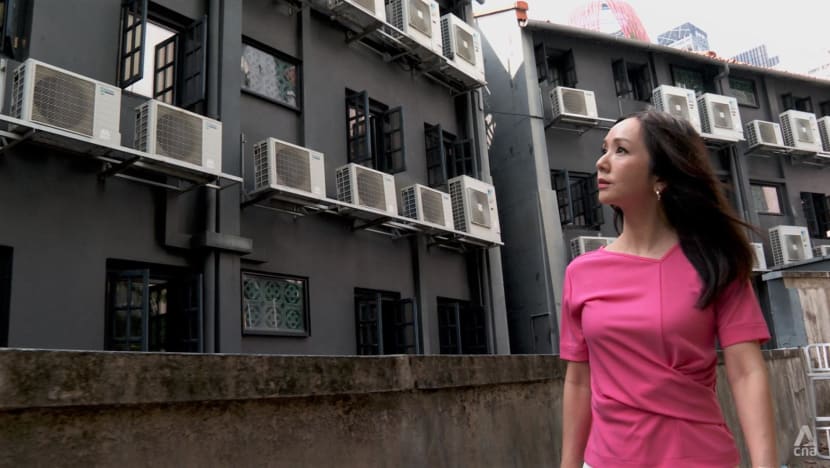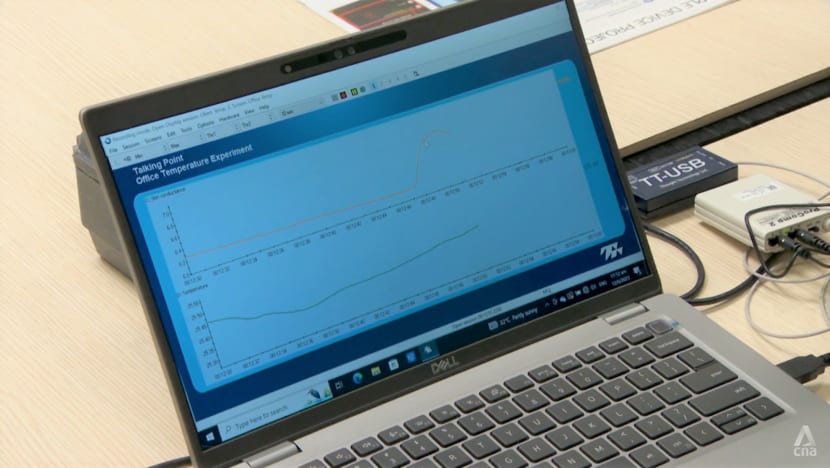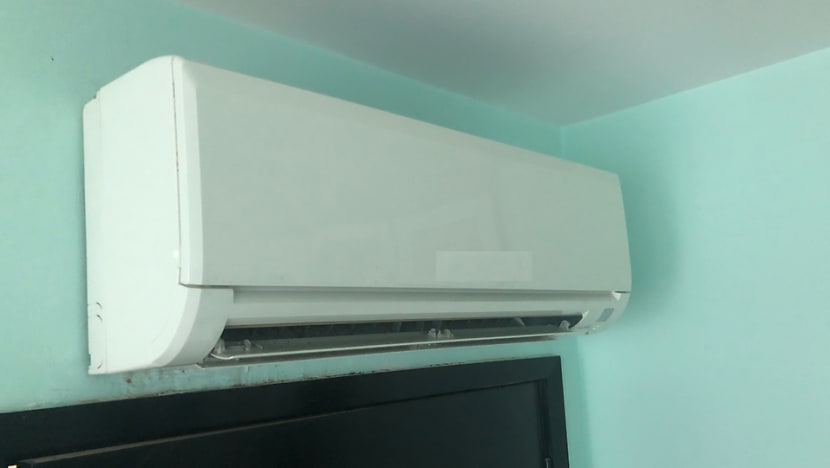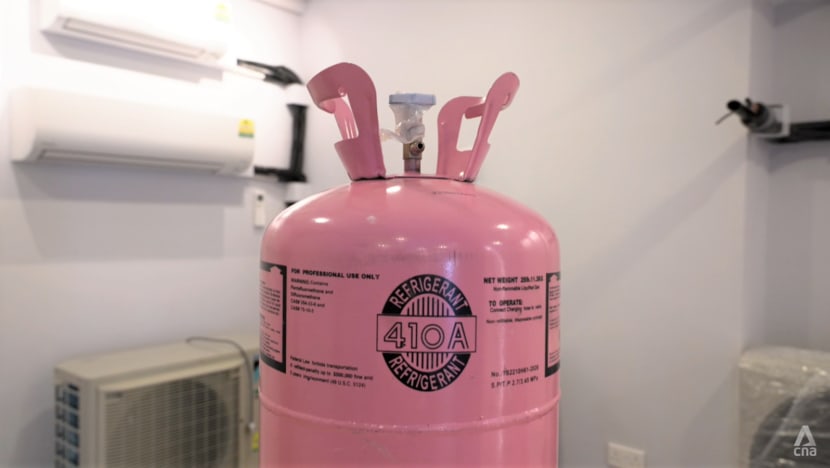What impact can 3 deg C have? The right air-con setting may boost productivity, and more
With rising temperatures outdoors, the programme Talking Point meets experts and experimenters to find out what makes 25 degrees Celsius a recommended temperature for air conditioning.

Talking Point host Diana Ser finds out the difference that even one degree Celsius makes.
SINGAPORE: When Lee Kuan Yew became Singapore’s prime minister in 1959, the first thing he did was to install air conditioners in government buildings. In his mind, air conditioning was the key to working efficiently.
But how cold is cool enough to be more productive? Something like 21 degrees Celsius or warmer instead?
Researchers at the Singapore University of Social Sciences (SUSS) now have the answer.
They got participants in an experiment to solve visual puzzles at two different room temperatures. And at 25 deg C, people performed cognitively faster than when it was cooler.
This is one of the ways in which turning the air-con up has an impact.

The programme Talking Point finds out what difference a few degrees can make — to productivity, electricity bills and the climate — and how to keep cool even amid the rising temperature outdoors.
WARMER ROOM, COOLER SKIN
What science tells us about air-con settings and our bodies is that the body regulates its internal temperature, keeping it to around 37 deg C ideally.
In a colder room, the body uses more energy to generate heat, possibly leaving less energy for mental tasks.
And in the SUSS experiment, where accuracy and reaction times were a proxy for productivity, while participants all performed the tests at similar levels of accuracy, reaction times were 10 per cent faster when the temperature was set at 25 deg C instead of 21 deg C.

That was not the only result. “It was really interesting, physiologically,” said experimenter and SUSS associate professor Emily Ortega. “With skin temperature, it was quite clear that it kept going down in the slightly warmer condition.”
The convergence of lower skin temperatures and faster reaction times points to 25 deg C as more conducive to working, even though many of the participants, before the experiment, thought the colder the room, the higher their productivity.
“Now we have some kind of evidence to suggest that what you think isn’t what you get,” said experimenter Ooi Seok Hui.
The National Environment Agency advises setting the air-con at 25 deg C as an energy-saving tip. And there is also research behind this.
Air-conditioning and Refrigeration Association president Leong Cheng Wee, citing the famed thermal engineer Povl Ole Fanger, said comfortable temperatures can range between 22 and 27 deg C.
WATCH: What is the best temperature to set my air conditioner? (22:25)
“We normally tend to select right in the middle,” said Leong. “This is normally the sweet spot: At least 80 per cent of the target audience is satisfied.”
So why are buildings in Singapore so cold? Because “it’s easier to over-cool than to under-cool”, he said, since people who are cold can wear a jacket, whereas those who are warm cannot really be removing their clothes.
SAVING MONEY AND THE ENVIRONMENT
How much savings, then, can turning the air-con up deliver?
In a test done by Giridharan Karunagaran, the director of the Singapore Berkeley Building Efficiency and Sustainability in the Tropics research programme, the air-con in two rooms covering 50 square metres was set at three temperatures.
The first setting was at 22 deg C, then 23 deg C, followed by 25 deg C, and the power consumption was measured.
The energy savings from going from 22 deg C to 23 deg C amounted to nine per cent, or S$72 yearly if the air-con is used for eight hours per day, 20 days per month, with the tariff rate unchanged.
Going from 22 deg C to 25 deg C delivered savings of 34 per cent, or about S$278 per year. But it need not stop there. “You’ll indeed save a lot more energy for every (one-)degree increase,” said Giridharan.
Besides cutting down on power bills, turning the air-con up can also help to lower greenhouse gas emissions.
Air-con systems remove heat from homes in a process called the refrigeration cycle, the same process that cools refrigerators.

This process is driven by the compressor outside the home: It moves a chemical called a refrigerant between the coils connecting the outdoor and indoor units and requires the most energy in the air-con system.
Meanwhile, the refrigerant — made up of hydrofluorocarbons, which are much more potent greenhouse gases than carbon dioxide — absorbs heat from the rooms and expels it outside.
One kilogramme of refrigerant has the same greenhouse impact as driving a small car from Changi to Jurong 500 times. Cooling emissions, caused by energy consumption and refrigerants, account for about 11 per cent of Singapore’s greenhouse gas emissions.
By increasing the temperature from 22 deg C to 25 deg C, households can lower their carbon emissions by 30 per cent. Every increase of 1 deg C reduces carbon emissions by 10 per cent and electricity costs even further.

MORE DEVICES BUT LESS EXPENSIVE
In fact, some Singaporeans may not be keeping cool efficiently.
Aaron Wu of Amyth Aircon Services, who shares air-con tips with his company’s 16,000 followers on TikTok, visited some homes to see if people were inadvertently working their air-con units harder than they needed to.
In one home, he found an air-con unit blasting cold air while a window was slightly open. A thermal camera provided by Talking Point showed heat entering the room.
This also caused cool air to escape, said Wu, and the air-con had to work “very hard” to maintain the room temperature according to the setting.

Besides closing windows and doors, one could increase the unit’s fan speed to cool a room down instead of setting a lower temperature, he advised. “Let the cold air disperse,” he said, “and you’ll enjoy the cooling facility faster".
Using a ceiling or standing fan to circulate cool air from the air-con also helps to bring the temperature down, he added. This is called hybrid cooling.
With hybrid cooling, the air-con could be set as high as 27 deg C without compromising comfort — or productivity. And this concurrent use of cooling devices consumes less energy than lowering the air-con temperature.
Watch this episode of Talking Point here. The programme airs on Channel 5 every Thursday at 9.30pm.






